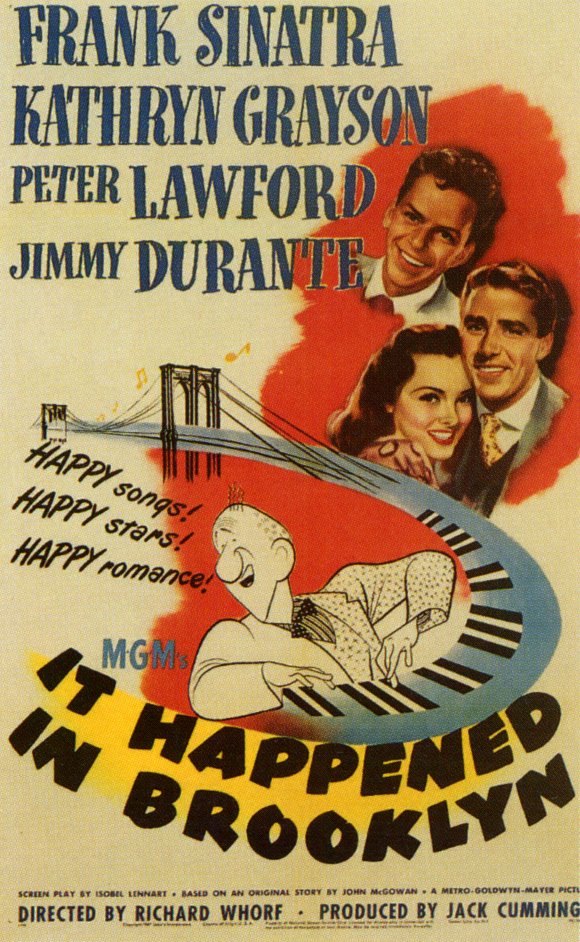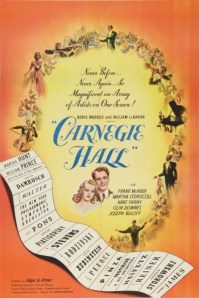
It Happened in Brooklyn (1947)
Directed by Richard Whorf
Metro-Goldwyn-Mayer
I used to be bummed out that I grew up after the era of listening booths in record stores.
After seeing Richard Whorf’s It Happened in Brooklyn, I’ve realized that as far as regrets go, that’s small potatoes. If this film is to be believed, there was once a music store in Bay Ridge where you could pick out any piece of sheet music and hand it to Frank Sinatra, the in-house “song demonstrator,” and listen to Ol’ Blue Eyes tickle the ivories while he performed it for you. Sure, you had to contend with a teeming crowd of sighing bobby-soxers, but that’s a small price to pay.
When It Happened in Brooklyn begins, Private Danny Miller (Sinatra) has been in the service for four years. World War II is drawing to a close, and he can’t wait to get home to his one true love, Brooklyn.
Danny loves Brooklyn so much that he carries a picture of the Brooklyn Bridge in his wallet. When a pretty Army nurse (Gloria Grahame) from Brooklyn refuses to believe that Danny is really from Brooklyn because he’s so restrained and cool, he pulls out the picture of the bridge and says, “Sure, that’s my pinup girl. Ain’t she a beauty?”
When Danny returns home, a traffic cop asks him why he’s so happy to be in Brooklyn when he could be across the river in New York. Danny looks incredulous and exclaims, “New York? That’s a place to look at Brooklyn from!”
Faced with the post-war housing shortage, Danny moves in with Nick Lombardi (Jimmy Durante), the janitor at New Utrecht High School, Danny’s alma mater. Nick is a kindly old geezer who idolizes the fictional teacher Mr. Chips, and doesn’t understand why all the kids in the school make fun of him.
Danny also befriends a pretty music teacher named Anne Fielding (Kathryn Grayson) and, in a remarkable example of art imitating life, teaches a British drip named Jamie Shellgrove (Peter Lawford) how to be cool.
For an MGM musical, It Happened in Brooklyn is fairly restrained. Unlike Sinatra’s previous film, the Technicolor extravaganza Anchors Aweigh (1945), which also co-starred Grayson, It Happened in Brooklyn is filmed in black and white, clocks in at under two hours, and doesn’t feature any huge production numbers.
Despite this, It Happened in Brooklyn is still a blast, especially if you’re a Sinatra fan. It’s packed with great songs by Sammy Cahn and Jule Styne, including “The Brooklyn Bridge,” “Whose Baby Are You?,” “It’s the Same Old Dream,” “The Song’s Gotta Come From the Heart,” and the classic “Time After Time.” I especially enjoyed Sinatra and Durante’s humorous performance of “I Believe” with a teenaged actor named Bobby Long, who does a great tap number. Does anyone know anything about Long? Why didn’t he ever appear in another movie? Did he have an abrasive personality? Horrible skin? Did he sleep with a producer’s wife after wooing her with his sensuous tap-dancing?
Along with all the great pop numbers, there’s a little “class” squeezed in, too. The classically trained Grayson gets to belt out a couple of operatic numbers — one from Mozart’s Don Giovanni and one from Delibes’s Lakmé — and her student Leo Kardos (Billy Roy) performs a piano concert in hopes of getting a scholarship. (Kardos’s playing was actually done by André Previn, who had just joined the music department of MGM at the age of 17.)
It Happened in Brooklyn is clichéd and occasionally silly, and it doesn’t offer the over-the-top razzle-dazzle of Anchors Aweigh, but it’s still a whole lot of fun.

